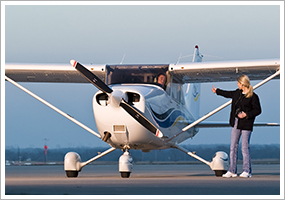| The following stories from the June 18, 2010, edition of AOPA ePilot were provided to AOPA members who expressed an interest in the particular subject areas. Any AOPA member can receive information tailored to their areas of interest by updating their preferences online. training tipsMany meanings of ‘solo’
Take “solo.” To most student pilots, it’s obvious that solo refers to the time when they fly the aircraft alone. However there have been cases (and accidents) in which student pilots espoused the incorrect idea that someone such as a friend who was a certificated pilot could accompany them on solo flights. Not so! “From a legal standpoint, Federal Aviation Regulation 61.87 says that the term ‘solo flight as used in this subpart means that flight time during which a student pilot is the sole occupant of the aircraft.’ A common industry definition says ‘solo’ is any flight time during which the pilot is the only occupant on board,” states the Flight Training website’s Pre-Solo FAQ page.
Compliance with a flight instructor’s logbook endorsements and limitations is another responsibility of the soloing student pilot. But the instructor’s supervisory role is also tightly defined; you, the student, should never feel that you have been left alone to decide whether to make a flight. Compare your procedures with the case of a cross-country flight described in the February 2003 Flight Training “Legal Briefing” column.
A student pilot is subject to specially prescribed operational guidelines under visual flight rules. One such condition is the requirement that the flight always have visual reference to the surface. Kathy Yodice elaborated on this idea in the November 2009 Flight Training: “Thus, flying over a ‘cloud deck,’ even if it is not a solid deck of clouds but scattered or broken, and even if it is only for a limited time during an otherwise beautiful VFR flight, is not allowed for student pilots since doing so inhibits the student’s ability to see the ground.” Was that your understanding?
Despite curtailments, there is recognition that you are commander of your aircraft when soloing. Meet that challenge by training with the solo courses and quizzes offered by the AOPA Air Safety Foundation. Act in the name of safety, and your decisions will always reflect your best judgment. training productsWingX on the iPadThe iPad is already revolutionizing aviation applications with the ability to cheaply and easily carry a full flight planning suite, moving maps, and approach charts anywhere you go. WingX is a pioneer in aviation applications, and its new iPad app features terrain-enhanced moving maps, a flight planning interface for CSC DUATS, and approach charts. The application is $99 from the Apple store. Note: Products listed have not been evaluated by ePilot editors unless otherwise noted. AOPA assumes no responsibility for products or services listed or for claims or actions by manufacturers or vendors. final examQuestion: I sometimes get confused by the different classifications of airspace. Can you explain to me the different types of airspace?
Answer: There are basically two kinds of airspace: controlled and uncontrolled. Class A, B, C, D, and E airspace are all considered to be controlled airspace, which is “airspace of defined dimensions within which air traffic control service is provided to IFR flights and to VFR flights in accordance with the airspace classification.” Class G airspace is any airspace not designated as A, B, C, D, or E, and is defined as uncontrolled airspace. There are various regulatory requirements for operations within each of these airspace classifications. For detailed information, see the AOPA Air Safety Foundation’s Airspace for Everyone Safety Advisor and the Flight Training article, “Airspace ABCs.”
Got a question for our technical services staff? E-mail [email protected] or call the Pilot Information Center, 800/872-2672. Don’t forget the online archive of “Final Exam” questions and answers, searchable by keyword or topic. |
 The June 11, 2010, “
The June 11, 2010, “ 

